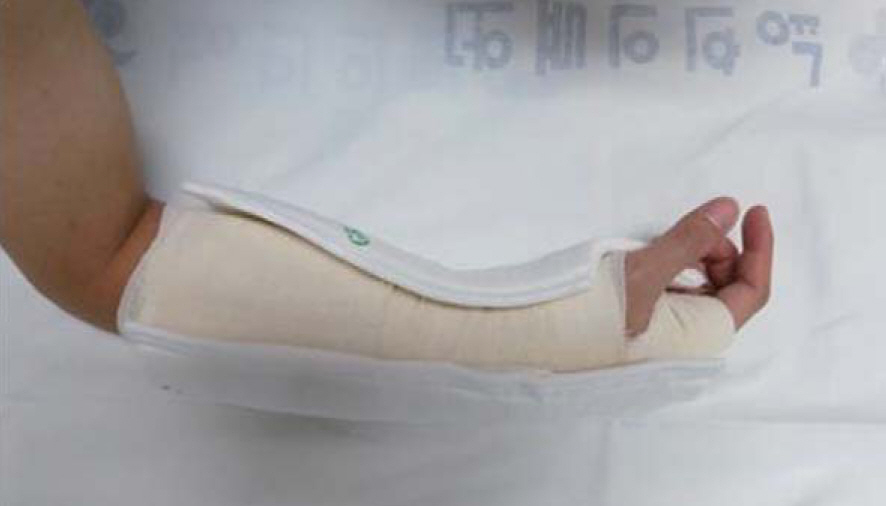J Korean Soc Surg Hand.
2015 Sep;20(3):104-109. 10.12790/jkssh.2015.20.3.104.
Effect of Different Splints on Displacement after Closed Reduction of the Distal Radius Fractures: A Comparison of Short Arm Double Splint and Sugar-Tong Splint
- Affiliations
-
- 1Department of Orthopedic Surgery, Kyung Hee University Hospital at Gangdong, Seoul, Korea. ljhos69@naver.com
- 2Department of Orthopedic Surgery, Kyung Hee Medical Center, Seoul, Korea.
- KMID: 2068815
- DOI: http://doi.org/10.12790/jkssh.2015.20.3.104
Abstract
- PURPOSE
This study was to compare short arm double splint allowing forearm rotation with sugar tong splint in terms of loss of reduction and incidence of shoulder stiffness after closed reduction of the distal radius factures.
METHODS
From June 2012 to February 2013, we retrospectively reviewed patients with distal radius fractures applied short arm double splint or sugar tong splint after closed reduction. Patients with more than 18 years old, acceptable reduction in X-ray and followed up at least 4 weeks were enrolled. Short arm double splint (SD) group was applied in 47 cases and sugar tong splint (ST) group was 34 cases. Gender, age and fracture types were not significantly different between two groups. The radiographic parameters were measured for palmar tilt, articular step-off, radial length, radial inclination, ulnar variance. The incidence and time of the reduction loss were also evaluated. In functional outcomes, the occurence of ipsilateral shoulder stiffness and the disabilities of the arm, shoulder and hand (DASH) score were evaluated with the medical records or telephone questionnaires at 6 months after initial trauma.
RESULTS
Loss of reduction was occured 16 cases in SD group (34%) and 10 cases in ST group (29.4%), which did not differ significantly between the groups (p=0.169). The DASH score and shoulder stiffness were not statistically different between two groups.
CONCLUSION
There was no significant difference in loss of reduction after closed reduction of distal radius fractures and functional outcomes in both groups.
MeSH Terms
Figure
Cited by 1 articles
-
Nonsurgical Treatment of a Distal Radius Fracture: When & How?
Young Ho Shin, Jun O Yoon, Jae Kwang Kim
J Korean Fract Soc. 2018;31(2):71-78. doi: 10.12671/jkfs.2018.31.2.71.
Reference
-
References
1. Thompson PW, Taylor J, Dawson A. The annual incidence and seasonal variation of fractures of the distal radius in men and women over 25 years in Dorset, UK. Injury. 2004; 35:462–6.
Article2. Cummings SR, Black DM, Rubin SM. Lifetime risks of hip, Colles', or vertebral fracture and coronary heart disease among white postmenopausal women. Arch Intern Med. 1989; 149:2445–8.
Article3. Solgaard S, Petersen VS. Epidemiology of distal radius fractures. Acta Orthop Scand. 1985; 56:391–3.
Article4. O'Neill TW, Cooper C, Finn JD, et al. Incidence of distal forearm fracture in British men and women. Osteoporos Int. 2001; 12:555–8.5. Singer BR, McLauchlan GJ, Robinson CM, Christie J. Epidemiology of fractures in 15,000 adults: the influence of age and gender. J Bone Joint Surg Br. 1998; 80:243–8.6. Bong MR, Egol KA, Leibman M, Koval KJ. A comparison of immediate postreduction splinting constructs for controlling initial displacement of fractures of the distal radius: a prospective randomized study of long-arm versus short-arm splinting. J Hand Surg Am. 2006; 31:766–70.
Article7. Grafstein E, Stenstrom R, Christenson J, et al. A prospective randomized controlled trial comparing circumferential casting and splinting in displaced Colles fractures. CJEM. 2010; 12:192–200.
Article8. Frykman G. Fracture of the distal radius including sequelae: shoulder-hand-finger syndrome, disturbance in the distal radio-ulnar joint and impairment of nerve function. A clinical and experimental study. Acta Orthop Scand. 1967; (Suppl 108):3+.9. Gummesson C, Atroshi I, Ekdahl C. The disabilities of the arm, shoulder and hand (DASH) outcome questionnaire: longitudinal construct validity and measuring self-rated health change after surgery. BMC Musculoskelet Disord. 2003; 4:11.
Article10. Arora R, Gabl M, Gschwentner M, Deml C, Krappinger D, Lutz M. A comparative study of clinical and radiologic outcomes of unstable colles type distal radius fractures in patients older than 70 years: nonoperative treatment versus volar locking plating. J Orthop Trauma. 2009; 23:237–42.
Article11. Aktekin CN, Altay M, Gursoy Z, Aktekin LA, Ozturk AM, Tabak AY. Comparison between external fixation and cast treatment in the management of distal radius fractures in patients aged 65 years and older. J Hand Surg Am. 2010; 35:736–42.
Article12. Diaz-Garcia RJ, Oda T, Shauver MJ, Chung KC. A systematic review of outcomes and complications of treating unstable distal radius fractures in the elderly. J Hand Surg Am. 2011; 36:824–35.e2.
Article13. Kreder HJ, Hanel DP, McKee M, Jupiter J, McGillivary G, Swiontkowski MF. Consistency of AO fracture classification for the distal radius. J Bone Joint Surg Br. 1996; 78:726–31.
Article
- Full Text Links
- Actions
-
Cited
- CITED
-
- Close
- Share
- Similar articles
-
- A Comparison of Sugar Tong Splint and Radial Gutter Short Arm Splint after Closed Reduction of Distal Radius Fracture
- A Clinical Study of Colles' Fracture Treated by Closed Reduction and Sugar Tong Splint
- Conservative Treatment for Distal Radius Fractures
- A Clinical Study of Colles Fractures
- The Availability of Three-Dimensional Computed Tomography Reconstructions on the Classification and Treatment Plan of Distal Radius Fractures


